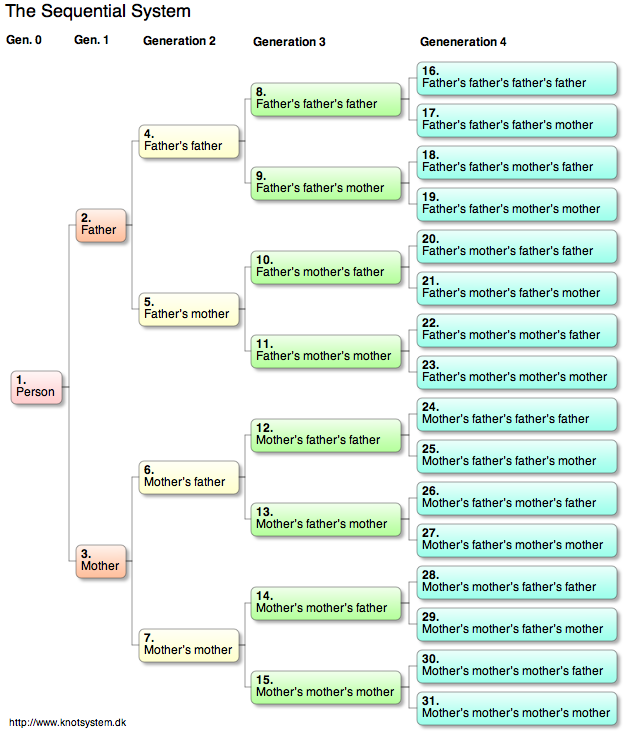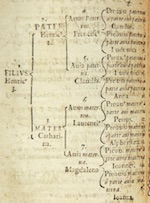The Sequential System
For centuries, humans have sought methods to describe relationships. The most common practice is to assign names to the kinships, such as father, mother, sister, brother, uncle, niece, grandfather etc. However, these verbal terms do not define consanguinity precisely enough for maximum scientific use.
Geneticists and genealogists need a system that permits them to comprehend more complex relations than those
traditionally possible. Sir Francis Galton
(1822-1911) stated the problem more than a century ago in a letter to the editor of Nature, concerning an
Arithmetic Notation of Kinship
:
Many writers have endeavoured to devise a simple method of describing the various forms of kinship, which, when expressed verbally, are cumbrous and puzzling in the highest degree. I suspect, however, that if we had always been as familiar with the binary system of arithmetic as we are with the decimal, that the facilities afforded by a numerical system of notation of kinship would have been so obvious that it would have been adopted as a matter of course.
Galton's letter briefly discusses the sequential numbering scheme for ancestors now known by European genealogists as the Kekule von Stradonitz System and by North American genealogists as the Stradonitz or Ahnentafel System. However, the plan was invented by neither Sir Francis Galton nor Stephen Kekule von Stradonitz (1863-1933). The latter's name is attached to it because he was the first to describe its properties (in 1898).
The first printed version of this arrangement dates back to 1590, when an Austrian historian and diplomat, Michael Eyzinger (Michael von Aitzing, 1530-1598), used it in his book on European princely and royal houses. The scheme is so simple and logical that many genealogists since then have used it without knowledge of predecessors and even without considering it in need of explanation. On this homepage the method is referred to as the Sequential System.
The Sequential System
Widely accepted as the preferred notation for documentation and exchange of genealogical research data about ancestors, its plan is simple. Consecutive integers (whole numbers) are assigned to all ancestors of a person - 1 to the person, 2 to the father, 3 to the mother, 4 to the father's father, etc.
Because each person has a countable number of ancestors and there exists an infinite number of integers, it is possible to assign a correct number to any ancestral position, even if some positions remain unidentified. Because of the inherent binary structure of bisexual procreation, many properties may be derived directly from this numbering plan.

Properties of the Sequential System
Gender
Male ancestral positions have even numbers; female ancestral positions have odd numbers.
Parents
The father of any ancestor n has number 2n, and the mother has number
2n + 1.
Offspring
The offspring position of any ancestor n is calculated as the integer part of
n/2.
Mate
A male ancestor n's mate has number n + 1, and a female ancestor
n's mate
has number n - 1.
Relationship
The exact relationship between any ancestor n and the
individual at position 1 is calculated by successively dividing n by 2, discarding fractions at each stage,
until reaching the number 1. The resulting list of integers identifies the ancestral positions that form the lineage.
The number of times that n is halved equals the number of generations between the individual and the ancestor
at position n.
Ancestors per generation
The first ancestor number in every generation (1, 2, 4, 8, 16, etc.) corresponds
to the number of ancestor positions in that generation.
Generation numbers
Above ancestor numbers are also exponentiations of 2 (i.e., 20, 21,
22, 23, 24, etc.), and the exponent may be used as the generation number
(i.e., 24 - or, 2 to the fourth power - represents the fourth ancestral generation).
Relationship type
Pure male (agnatic) ascent from an individual exists for ancestor
position numbers which are a power of 2
(2, 4, 8, . .).
Pure female ascent exists for ancestor position
numbers which are power of 2 minus 1
(3, 7, 15, . . ).
| Generation number | Pure male ascent |
Ancestor pos. father's side | | | | Ancestor pos. mother's side | Pure female ascent |
| n | 2n | | | 2n+1 - 1 | ||
| 15 | 32,768 | 32,768 - 49,407 | | | 49,408 - 65,535 | 65,535 |
| 14 | 16.384 | 16,384 - 24,703 | | | 24,704 - 32,767 | 32,767 |
| 13 | 8,192 | 8,192 - 12,351 | | | 12,352 - 16,383 | 16,383 |
| 12 | 4,096 | 4,096 - 6,175 | | | 6,176 - 8,191 | 8,191 |
| 11 | 2,048 | 2,048 - 3,087 | | | 3,088 - 4,095 | 4,095 |
| 10 | 1,024 | 1,024 - 1,543 | | | 1,544 - 2,047 | 2,047 |
| 9 | 512 | 512 - 771 | | | 772 - 1,023 | 1,023 |
| 8 | 256 | 256 - 385 | | | 386 - 511 | 511 |
| 7 | 128 | 128 - 191 | | | 192 - 255 | 255 |
| 6 | 64 | 64 - 95 | | | 96 - 127 | 127 |
| 5 | 32 | 32 - 47 | | | 48 - 63 | 63 |
| 4 | 16 | 16 - 23 | | | 24 - 31 | 31 |
| 3 | 8 | 8 - 11 | | | 9 - 15 | 15 |
| 2 | 4 | 4 - 5 | | | 6 - 7 | 7 |
| 1 | 2 | 2 | | | 3 | 3 |
| 0 | 1 | ||||
| Proband | |||||


